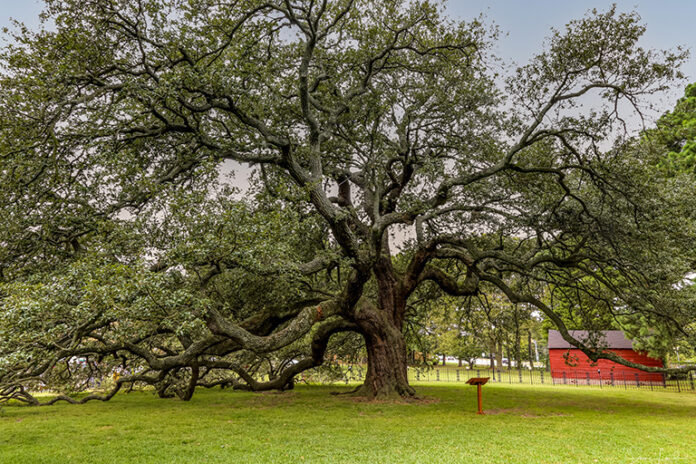By Debi Lander
mail@floridanewsline.com
While I don’t consider myself a tree hugger (environmental campaigner),
I am very fond of trees. I’m especially attracted to those with historical significance or those of considerable size. Here is a list of some significant trees I have encountered in the South.

Let’s start in Jacksonville. The Treaty Oak, located downtown in Jessie Dupont Park, was saved by what we’d now call fake news. In the 1930s, developers started eyeing the land around the tree. Florida Times-Union journalist Pat Moran devised a story about a treaty between Native Americans and white settlers being signed under the oak, making it a local landmark. Together with the extensive efforts of the Garden Club of Jacksonville, this story ensured that the magnificent oak was saved.
Farther south in Fort Myers, Florida, you will find the largest banyan tree in the Continental United States. It stands, along with a statue of Edison, on the garden-like grounds of the Museum. Banyan trees only grow in the farthest reaches of the state, as they are not cold tolerant. The multi-footed tree at Edison Ford, believed to have been planted around 1925, has grown a canopy covering at least one acre of land.
Moving slightly north to the historic district of Jekyll Island, you’ll find a regal live oak. The Plantation Oak dates to the mid-17th century, making it approximately 375 years old. The trunk spans seven feet eight inches in diameter.
At the southern end of nearby St. Simons Island, look for the Avenue of the Oaks. Planted in 1826, the lane of trees now forms the grand entrance to the Sea Island Golf Club.
The Angel Oak, near Charleston, South Carolina serves a whopping 17,200 square feet of shade and is believed to be somewhere between 500 to 1,500 years old (its exact age remains contested). The tree carries historical significance as well. During segregation, both African-American and white families would picnic under the sheltering limbs, making the area a small haven from racial strife. Drive 12 miles southwest of the city to Johns Island to find it.
In Hampton, Virginia (near Norfolk), I discovered the Emancipation Oak. The tree lies on the campus of Hampton University and marks the spot where, in 1863, the first Southern reading of the Emancipation Proclamation occurred. At this location, Union General Benjamin F. Butler gave shelter to fugitive slaves as “contraband of war” early in the Civil War. Then, the sprawling oak served as the first classroom that newly free children and adults could attend. By 1863, the Butler School was constructed beside the tree. Standing under its limbs brought a poignant experience; I personally felt I was nestled deep in history. Indeed, climbing is prohibited today, but I’m sure many found a cozy spot to sit within the branches of this oak.
If you head toward Louisiana, you can walk up the famous entryway of arching branches at Oak Alley. Over at nearby Evergreen Plantation, still a working sugar cane producer, you will find similar oaks lining the entry to the slave cabins. While thousands of these buildings were once scattered across the American South, they are now exceedingly rare. This is the only place where they exist unchanged, except for slight repairs and stabilization efforts. This site has been used in several movies and is, no pun intended, moving. The trees and village remain to tell their story.
Feel free to write to me at mail@floridanewsline.com if you’ve encountered any trees on your travels that bring back memories.
Visit www.bylandersea.com to read more of local travel writer Debi Lander’s stories and travel tips.
Photo courtesy Debi Lander
Emancipation Oak in Hampton, Virginia.












